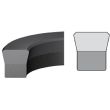RP-30
- Rod / Piston Seal NBR/Fabric Type: RP-30
Dimensions: 100 x 80 x 14Part number: 227992In StockMore Details - Rod / Piston Seal NBR/Fabric Type: RP-30
Dimensions: 101.6 x 88.9 x 10Part number: 314675Delivery time: 1 weekMore Details - Rod / Piston Seal NBR/Fabric Type: RP-30
Dimensions: 101.6 x 88.9 x 9.52Part number: 228022Delivery time: 1 weekMore Details - Rod / Piston Seal NBR/Fabric Type: RP-30
Dimensions: 102 x 90 x 9.6Part number: 317935In StockMore Details - Rod / Piston Seal NBR/Fabric Type: RP-30
Dimensions: 110 x 85 x 13.5Part number: 314674In StockMore Details - Rod / Piston Seal NBR/Fabric Type: RP-30
Dimensions: 110 x 90 x 12.5Part number: 228038In StockMore Details
RP-30
Description
The RP-30 is a single acting piston seal which consists of reinforced cotton fabric and nitrile rubber vulcanized together forming an integral sealing element.
Product advantages
- functions even with poor surfaces
- reinforced cotton fabric base prevents the seal from extrusion
- both rod and piston application
- good sealing at low pressures
Applications
Low to medium duty hydraulic cylinders, mobile hydraulics and presses.
Operating conditions
| Media | Mineral oils (DIN 51524) | HFA and HFB | HFC |
| Temperature (min.) °C | -30 | +5 | -30 |
| Temperature (max.) °C | +105 | +60 | +60 |
| Pressure Bar | ≤250 | ≤250 | ≤250 |
| Speed m/sec | ≤0,5 | ≤0,5 | ≤0,5 |
Note: The above data are maximum values and cannot be used at the same time.
Surface roughness
| Surface roughness | Ra | Rmax |
| Sliding Surface ØD-Ød | ≤0.4 μm | ≤3.2 μm |
| Groove Base ØDb-Ødp | ≤1.8 μm | ≤6.3 μm |
| Groove Flanks B | ≤3.2 μm | ≤16 μm |
Note: It is recommended to have 50% to 90% of the working surface value.

d (h9)/dp (f8)
Db (H11)/D(H9)
B (-0/+0.2)
Installation
The RP-30 is to be assembled into open grooves. It is very important that the assembly tools must be of soft material and have no sharp edges. Before installation the sealing element must be oiled with system oil.
permissible sealing gap
| pressure (bar) | 150 | 250 |
| Smax (mm.) | 0,20 | 0,10 |
Note: The largest sealing gap value occurring on the non-pressurized side of the seal does have a vital importance for the function of the seal and in this respect it is quite important to use the S value lower than the above indicated numbers.










